
Nana Saheb Peshwa II, born as Dhondu Pant, was an Indian Peshwa of the Maratha empire, aristocrat and fighter, who led the rebellion in Kanpur (Cawnpore) during the Great Revolt of 1857. As the adopted son of the exiled Maratha Peshwa Baji Rao II, Nana Saheb believed that he was entitled to a pension from the East India Company, but the underlying contractual issues are rather murky. The Company's refusal to continue the pension after his father's death, as well as what he perceived as high-handed policies, led him to join the rebellion. He forced the British garrison in Kanpur to surrender, then murdered the survivors, gaining control of Kanpur for a few days. He later disappeared, after his forces were defeated by a British force that recaptured Kanpur. He went to the Nepal Hills in 1859, where he is thought to have died.

jhansi city is a historic city in the Indian state of Uttar Pradesh. It lies in the region of Bundelkhand on the banks of the Pahuj River, in the extreme south of Uttar Pradesh. Jhansi is the administrative headquarters of Jhansi district and Jhansi division. Also called the Gateway to Bundelkhand, Jhansi is situated near and around the rivers Pahuj and Betwa at an average elevation of 285 m (935 ft). It is about 420 kilometres (261 mi) from New Delhi and 102 kilometres (63 mi)fromGwalior.

Shrimant Jayajirao Scindia GCB, GCSI, CIE of the Scindia dynasty of the Marathas was the ruling Maharajah of Gwalior under the British rule.
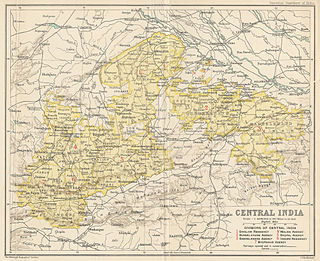
The Bundelkhand Agency was a political agency of the British Raj, managing the relations of the British government with the protected princely states of the Bundelkhand region.
The Central India Campaign was one of the last series of actions in the Indian rebellion of 1857. A small British and Indian Army overcame a disunited collection of states in a single rapid campaign, although determined rebels continued a guerrilla campaign until the spring of 1859.

Jhalkaribai was a woman soldier who played an important role in the Indian Rebellion of 1857. She served in the women's army of Rani Lakshmibai of Jhansi. She eventually rose to a position of a prominent advisor to the queen, Rani of Jhansi. At the height of the Siege of Jhansi, she disguised herself as the queen and fought on her behalf, on the front, allowing the queen to escape safely out of the fort.
Events in the year 1858 in India. Act of Parliament 1858
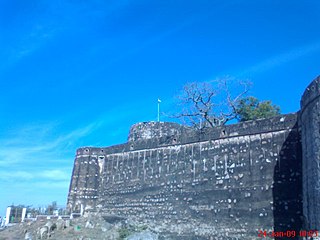
Jhansi Fort or Jhansi ka Kila is a fortress situated on a large hilltop called Bangira, in Uttar Pradesh, Northern India. It served as a stronghold of the Chandela Kings in Balwant Nagar from the 11th through the 17th century.

Ek Veer Stree Ki Kahaani... Jhansi Ki Rani is an Indian historical drama based on the life of Lakshmi Bai, the Rani of Jhansi. The series was directed by Jitendra Srivastava and written by Rajesh Saksham, Ila Dutta Bedi, Malavika Asthana, Mairaj Zaidi. It premiered on 18 August 2009 on Zee TV with Ulka Gupta playing young Queen Lakshmi Bai. On 8 June 2010, the story moved on several years and Kratika Sengar portrayed the Queen from there on. The last show episode aired on 19 June 2011 completing 480 episodes.

Jhansi was an independent princely state ruled by the Maratha Newalkar dynasty under suzerainty of British India from 1804 till 1853, when the British authorities took over State under the terms of the Doctrine of Lapse. Before that it was under the Peshwas from 1728 to 1804. The fortified town of Jhansi served as its capital.

Jhansi Ki Rani is a 1953 Indian Hindi-language historical drama film produced and directed by Sohrab Modi for his Minerva Movietone production banner. It is credited as the first Technicolor film made in India and starred Modi's wife, Mehtab in the title role, with Modi in the important role of her mentor, Rajguru. The film was dubbed in English as The Tiger and the Flame, which released in 1956 with the same star cast. The cast besides Mehtab and Sohrab Modi included Mubarak, Ulhas, Sapru, Ram Singh, Baby Shikha, Marconi and Shakila.

Maharaja Gangadhar Rao Newalkar was the 5th raja of Jhansi situated in northern India, a vassal of Maratha Empire. He was a Marathi Karhade Brahmin. He was the son of Shiv Rao Bhau and a descendant of Raghunath Hari Newalkar.

Baiza Bai was a Scindia maharani and banker. The third wife of Daulat Rao Scindia, she acceded to the regency of the Scindia kingdom following his death and ruled 1827-1833. As a prominent opponent of the East India Company, she was eventually ousted from power and replaced on the throne by her adopted son Jankoji Rao Scindia II.

Damodar Rao was the adopted son of Maharaja Gangadhar Rao and Rani Laxmibai of Jhansi State.
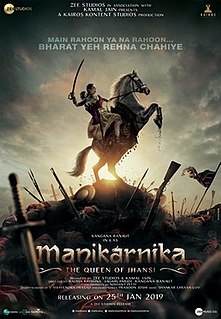
Manikarnika: The Queen of Jhansi is a 2019 Indian Hindi-language period drama film based on the life of Rani Lakshmi Bai of Jhansi. The film was directed by Radha Krishna Jagarlamudi and Kangana Ranaut, the screenplay was written by K. V. Vijayendra Prasad and it was produced by Zee Studios, Kamal Jain, and Nishant Pitti. The film stars Ranaut in the title role.
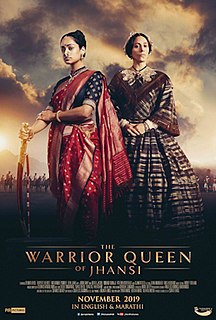
The Warrior Queen of Jhansi is a 2019 British period drama film on the 1857 Indian Rebellion against the British East India Company. The film was co-written, produced and directed by Swati Bhise, with Charles Salmon as co-producer. The film was originally titled Swords and Sceptres: The Rani of Jhansi. Devika Bhise, who also co-wrote the script, plays the lead role of Rani Lakshmibai. In November 2017, Rupert Everett and Derek Jacobi joined the cast. Principal photography was completed in December 2017.

Jhansi Ki Rani is an Indian historical drama television series based on the life of warrior queen Lakshmi Bai, the Rani of Jhansi. The show, starring Anushka Sen went to air on Colors TV on 11 February 2019. Due to low TRPs, the show ended on 12 July 2019 completing 110 episodes. It was replaced by Bahu Begum.

Newalkar dynasty were Marathi Karhade Brahmins, who were the Maharajas of Jhansi from 1769 to 1858. Their family deity was goddess Mahalakshmi. The Newalkars were sardars under Peshwa Madhavrao I, and later became Maharajas of Jhansi in Central India as an independent member of the Maratha Empire until 1818. Later, their kingdom became a princely state under the protectorate of British India.

Tantia Tope also spelled as Tatya Tope (16 February 1814 – 18 April 1859), was a general in the Indian Rebellion of 1857 and one of its notable leaders. Despite lacking formal military training, Tantia Tope is widely considered as the best and most effective rebel general.

The Indian independence movement was a series of historic events with the ultimate aim of ending British rule in India, lasting from 1857-1947. Women played a pivotal role in achieving India's independence. However, their lives, struggles, and contributions to the movement are never recognized at the same level of prominence as that of the men of the movement. Additionally, their names are seldom heard when discussing the independence movement, or mentioned in brief. Woman’s participation in India’s freedom struggle started as early as 1817. Bhima Bai Holkar fought against the British Colonel Malcolm and defeated him in guerrilla warfare. Throughout the twentieth century, numerous women continued to contribute to the movement through military leadership, political leadership, and social activism.
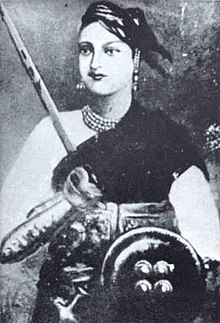
![]() pronunciation (help·info); 19 November 1828 — 18 June 1858), [1] [2] was an Indian queen, the Maharani consort of the Maratha princely state of Jhansi from 1843 to 1853 as the wife of Maharaja Gangadhar Rao. [3] She was one of the leading figures of the Indian Rebellion of 1857 and became a symbol of resistance to the British Raj for Indian nationalists.
pronunciation (help·info); 19 November 1828 — 18 June 1858), [1] [2] was an Indian queen, the Maharani consort of the Maratha princely state of Jhansi from 1843 to 1853 as the wife of Maharaja Gangadhar Rao. [3] She was one of the leading figures of the Indian Rebellion of 1857 and became a symbol of resistance to the British Raj for Indian nationalists.



























